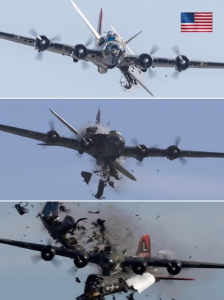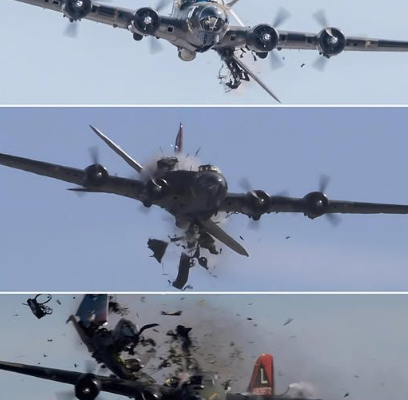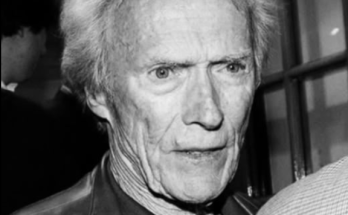Title: “Wings Over Silence”
The sky over Dallas was a brilliant canvas of blue on November 12, 2022. Families gathered at the Dallas Executive Airport for the Wings Over Dallas air show, a Veterans Day tribute featuring historic World War II aircraft. Children clutched cotton candy, veterans wore caps embroidered with faded unit insignias, and cameras pointed skyward in anticipation of the next pass.
Among the aircraft scheduled to perform were two legends of aviation: the Boeing B-17 Flying Fortress, known as Texas Raiders, and the Bell P-63 Kingcobra. Both were operated by the Commemorative Air Force, flown by experienced pilots who had spent years preserving the legacy of wartime aviation. These weren’t just machines—they were flying museums, symbols of sacrifice and resilience.
At 1:22 p.m., the show turned tragic.
The B-17, a lumbering four-engine bomber, was flying in a formation with other bombers, instructed to pass parallel to the crowd. The P-63, a sleek single-seat fighter, was part of a separate formation of fighters directed to cross in front of the bombers. According to eyewitnesses and later confirmed by the National Transportation Safety Board (NTSB), the P-63 banked sharply in a descending turn and collided with the B-17’s left wing.
In an instant, both aircraft shattered mid-air.
The crowd gasped. Some screamed. Others froze, unable to process what they had just witnessed. Debris rained down. Flames erupted. The sky, once filled with nostalgia and pride, was now a tableau of horror.
All six crew members aboard the two planes were killed. Five were aboard the B-17: the pilot, copilot, flight engineer, and two scanners. The sixth was the pilot of the P-63. No one on the ground was injured, but the emotional toll was immeasurable.
Lena Martinez, a retired Air Force mechanic, had brought her grandson to the show. She had worked on B-17s during her early career and wanted to share that history. “I told him, ‘That plane helped win the war,’” she later recalled. “And then it was gone. Just gone.”
The NTSB launched an investigation immediately. Preliminary findings revealed troubling gaps in safety protocols. There had been no altitude deconfliction briefing before the flight. The P-63’s GPS navigator failed to record any data. The air boss, responsible for coordinating the show, had relied on real-time directives and a “see-and-avoid” strategy—an approach that proved tragically insufficient.
In December 2024, the NTSB released its final report. The probable cause was identified as inadequate prebriefing and reliance on visual separation, compounded by a lack of FAA oversight of air bosses at air shows. It was a systemic failure, not just a momentary lapse.
But behind the technical language of the report were human stories—of passion, dedication, and loss.
Captain Terry Barker, one of the B-17 pilots, was a Vietnam veteran and retired airline captain. He had flown thousands of hours and was known for mentoring younger pilots. His co-pilot, Len Root, was a former schoolteacher who had taken up flying in retirement. Both were beloved in their communities.
The P-63 pilot, Curt Rowe, was a seasoned aviator with a deep love for vintage aircraft. He had flown in dozens of air shows and was meticulous about safety. His death shocked the tight-knit warbird community.
In the aftermath, tributes poured in. Memorials were held. Pilots across the country painted the tail numbers of the lost aircraft on their planes. The Commemorative Air Force vowed to improve safety protocols and honor the fallen by continuing their mission with renewed vigilance.
But for many, the tragedy raised deeper questions.
Why do we fly these aging aircraft in public demonstrations? Is the risk worth the reward? What does it mean to preserve history when the act of preservation itself can become perilous?
For Lena, the answer came slowly. She returned to the airfield months later, standing alone near the spot where the wreckage had fallen. The grass had grown back. The scorch marks had faded. But the memory remained.
She placed a small model of a B-17 on the ground and whispered a prayer.
“These planes carried our stories,” she said. “And the people who flew them carried our hearts.”
Reflection:
This story is not just about a collision—it’s about legacy, responsibility, and the fragile line between tribute and tragedy. It honors the lives lost while exploring the emotional resonance of historical preservation and the human cost of oversight.
If you’d like, I can expand this into a multi-part series, explore the perspectives of the families, or even fictionalize a survivor’s journey through grief and advocacy. Just say the word, and we’ll keep building


